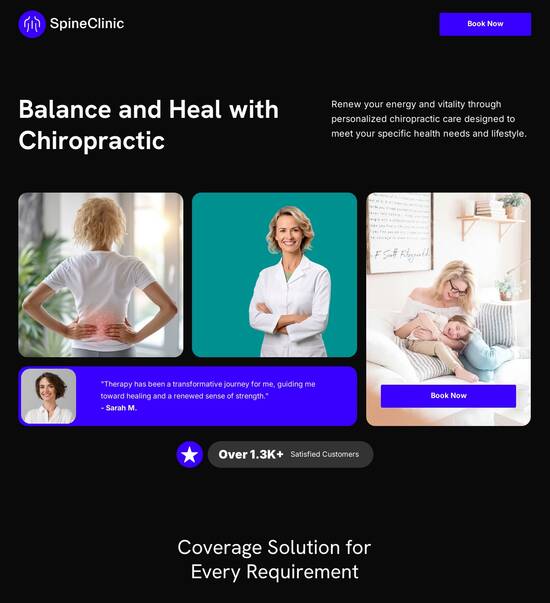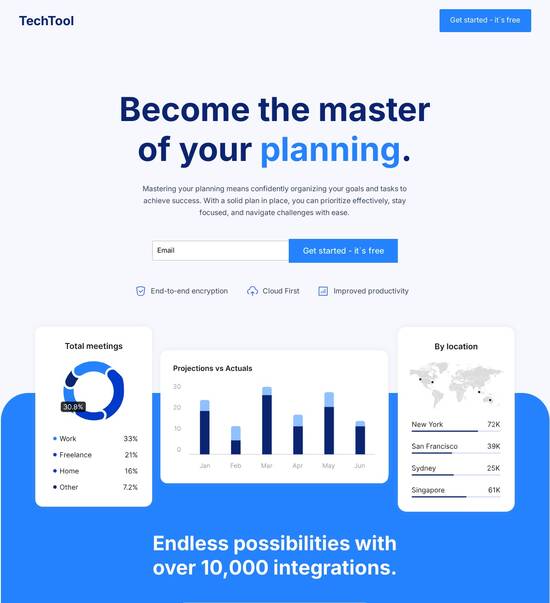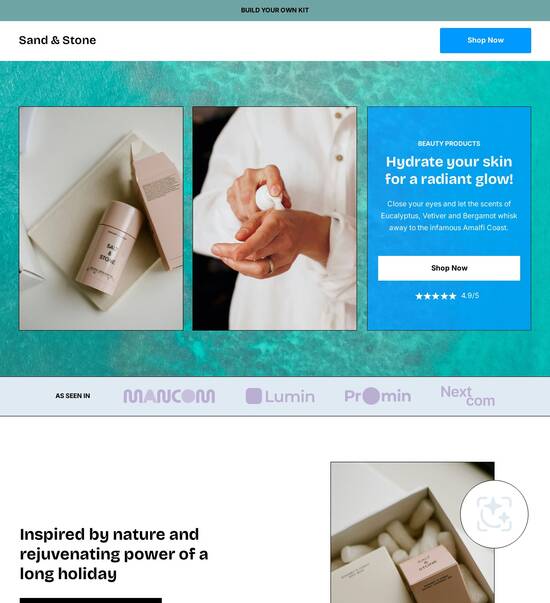
HTML page template for Warehousing
Use TemplateAbout template
Conquer your niche with our high-converting landing page templates for your Warehousing business. Let's boost conversion rates together!
Recommended templates

Easy to build without coding
With the intuitive drag-and-drop builder, anyone on your team can create high-converting pages without any knowledge of code or design. Make enhancements to your landing page with custom widgets using Javascript, HTML/CSS, or third-party scripts.

Multiple layouts for any industry and goal
Select from 500+ landing page layouts built to boost conversions across industry-specific scenarios. Customize them by adjusting fonts, adding images, and generating on-brand content with the AI assistant. Quickly scale with Instablocks® and Global Blocks that you can save, reuse, and update globally.

Loads fast and looks polished on any device
Every template is responsive, which means they present professionally on any device and load blazingly fast with our Thor Render Engine. You can also power them up with Google AMP technology to deliver an unparalleled mobile experience and drive higher conversions.

Robust analytics & experimentation
Get real-time updates and reporting across all your devices, showing the number of visitors, conversions, cost-per-visitor, and cost-per-lead. Launch AI-powered experiments, run A/B tests, and use heatmaps to analyze user behavior, then optimize your landing page to maximize conversions.







Easy to build without coding
With the intuitive drag-and-drop builder, anyone on your team can create high-converting pages without any knowledge of code or design. Make enhancements to your landing page with custom widgets using Javascript, HTML/CSS, or third-party scripts.
Multiple layouts for any industry and goal
Select from 500+ landing page layouts built to boost conversions across industry-specific scenarios. Customize them by adjusting fonts, adding images, and generating on-brand content with the AI assistant. Quickly scale with Instablocks® and Global Blocks that you can save, reuse, and update globally.
Loads fast and looks polished on any device
Every template is responsive, which means they present professionally on any device and load blazingly fast with our Thor Render Engine.
Robust analytics & experimentation
Get real-time updates and reporting across all your devices, showing the number of visitors, conversions, cost-per-visitor, and cost-per-lead. Launch AI-powered experiments, run A/B tests, and use heatmaps to analyze user behavior, then optimize your landing page to maximize conversions.
All the features you need to build lead-generating landing pages
Explore more featuresLearn how to build top-performing landing pages for any goal
FAQs
Leading the way in building high-performing landing pages





A comprehensive guide to optimizing landing pages with Instapage
In the competitive landscape of digital marketing, the effectiveness of your landing pages can significantly impact campaign performance and ROI. Instapage, recognized as the premier landing page and conversion rate optimization (CRO) platform, offers marketers the tools necessary to create high-converting pages quickly and easily. This guide will walk you through the essential steps for leveraging Instapage to enhance your marketing efforts.
Step 1: Understanding your target audience
Before designing your landing pages, it’s crucial to have a deep understanding of your target audience. This directs the content you create and ensures you meet their specific needs. Utilize customer personas and analytics to define key demographics and pain points.
- Identify demographics: Gather data on age, gender, location, and interests to tailor your content.
- Analyze customer behavior: Utilize analytics tools to track user interactions on your current pages.
- Solicit feedback: Use surveys or interviews to gain insights directly from your audience about their preferences.
Step 2: Crafting compelling content
Great content is the backbone of effective landing pages. Ensure your messaging resonates with your audience and clearly articulates your value proposition. Utilize powerful headlines and engaging visuals.
Step 3: Utilizing templates and lead generation elements
Instapage offers over 100 high-converting templates and lead generation elements that you can customize without prior coding experience. Here's how to maximize these features.
- Select the right template: Choose a layout that aligns with your marketing goals, whether it’s promoting a product or capturing leads.
- Incorporate lead generation forms: Use Instapage's pre-built forms strategically placed to encourage conversions.
- Leverage Instablocks: Save time by reusing previously created content blocks across different landing pages.
Step 4: Optimizing with personalization and A/B testing
To enhance conversions, personalize content for different audience segments and continuously test variations to identify what works best. Instapage provides tools to dynamically adapt content.
- Implement dynamic text replacement: Tailor page content based on the keywords users clicked on in ads.
- Run A/B tests: Experiment with different headlines, images, and CTAs to find the most effective combinations.
- Use analytics dashboards: Track performance metrics to understand user behavior on your landing pages.
By following these steps, marketers can harness the power of Instapage to significantly improve their landing pages and overall campaign performance.
Ready to boost your digital marketing efforts? Get started with Instapage today and elevate your landing page strategy!
Understanding HTML page templates for warehousing: A deep dive into functionality and impact
Defining the scope of HTML page templates in warehousing
HTML page templates serve as pre-structured layouts that streamline web content creation. In the warehousing industry, these templates are crucial for presenting complex data and information in a user-friendly manner. Warehousing operations demand high efficiency, and utilizing HTML templates can significantly improve the way information is disseminated to both internal and external stakeholders.
The importance of HTML templates in warehousing lies not only in their ability to organize content but also in their capacity to adapt to diverse operational needs. As businesses scale, the requirement for clear, accessible, and modifiable online resources becomes more pronounced. This is particularly critical in warehousing, where up-to-the-minute information can affect everything from inventory management to customer satisfaction.
Core features of HTML page templates for warehousing
HTML templates come equipped with a variety of features tailored to meet the specific demands of warehousing. One notable component is the pre-designed layouts which often include grid systems. These layouts facilitate the effective representation of large datasets, enabling seamless navigation through inventory and logistics information. Customizable sections within these templates allow businesses to adapt the content to reflect unique warehousing needs.
Moreover, responsiveness and mobile optimization have become critical in today's operations. Warehousing personnel often require access to real-time data and updates while on the go. Techniques such as using flexible grid layouts and media queries ensure that these templates function seamlessly across multiple devices, from desktop computers to smartphones. This versatility not only enhances user experience but also ensures that stakeholders can retrieve vital information, increasing overall productivity.
Interaction and engagement through advanced functionality
Advanced functionality within HTML templates enhances user interaction, particularly in warehousing settings. By incorporating JavaScript functions, these templates can create a more engaging user experience. For instance, functions such as dynamic sorting and filtering of inventory lists provide users the flexibility to interact with data according to their specific needs. Whether it's checking stock levels or assessing the status of overdue deliveries, robust JavaScript functionalities keep operations running smoothly.
The role of `document.addeventlistener` is paramount in facilitating interactive features within these templates. Through event listeners, actions such as clicks or keyboard inputs can trigger specific responses, such as displaying additional information or updating content dynamically. Consider the scenario of a warehouse employee scanning barcodes with a mobile device; an event listener can initiate an automatic update of the corresponding stock levels on the web interface, ensuring real-time accuracy in inventory management.
Enhancing user experience with DOM manipulation
Understanding the role of DOM (Document Object Model) manipulation can significantly enhance user experience in HTML templates for warehousing. The `DOMContentLoaded` event is crucial for determining when the template is fully prepared for interaction. Ensuring that the DOM is loaded before any scripts execute can prevent errors and improve page responsiveness, which is vital when users rely on these templates for quick decision-making.
Practical applications of DOM manipulation in warehousing are numerous. For instance, displaying real-time inventory updates can be achieved through regular AJAX calls to fetch the latest data. Additionally, customizing interface elements based on user interactions—such as changing the layout according to the user’s preferences—can also be implemented through DOM manipulation techniques. This flexibility ensures that the template evolves with the changing needs of warehouse operations.
Designing for optimization and performance
When developing HTML templates for warehousing, best practices for optimization and performance cannot be overlooked. Maintaining code cleanliness is critical; unoptimized code can lead to increased load times and a fragmented user experience. Ensuring that HTML structures remain streamlined with proper indentation and comments helps in both debugging and future modifications, boosting overall efficiency.
Moreover, SEO considerations play a vital role in making warehousing templates search-engine friendly. Strategies such as incorporating relevant keywords, crafting user-friendly URLs, and utilizing proper meta tags contribute to better visibility which is crucial in attracting potential clients or partners. A responsive design not only optimizes user experience but also aligns with modern SEO practices, ensuring that the HTML templates perform well across various search engine results.
Case studies: Success stories in warehousing template implementation
Examining real-world examples provides insight into the effectiveness of HTML templates in the warehousing sector. One notable case is a company that successfully streamlined its inventory management system by implementing a tailored HTML template. By leveraging pre-designed layouts that accommodated specific inventory categories, the company achieved a significant reduction in time spent on stock tracking and reporting.
Another success story involves a warehousing firm that improved communication with its stakeholders through well-structured HTML templates. These templates facilitated clear information sharing regarding shipment status and delivery timelines. The structured presentation of data helped build trust with customers, enhancing overall engagement. Furthermore, the adaptability of their templates allowed them to scale operations effectively, demonstrating how HTML templates can evolve with business growth.
Future trends in HTML template development for warehousing
As technology evolves, so does the development of HTML templates for warehousing. The impact of emerging technologies such as artificial intelligence and machine learning is beginning to shape how these templates are designed. For example, predictive analytics may soon be integrated into templates to assist businesses in inventory tracking and user engagement, ultimately guiding strategic decisions.
Customization and personalization are also on the rise. Increasingly, businesses are looking for templates that can cater to niche warehousing services by providing unique functionalities tailored to specific industry requirements. There is a growing expectation for user experience to improve further, suggesting that future HTML templates will focus on interactivity, personalization, and enhanced functionality to meet diverse operational challenges effectively.
Conclusion: The integral role of HTML templates in evolving warehousing operations
In summary, the comprehensive features of HTML page templates play a notable role in enhancing warehousing operations. From pre-designed layouts to mobile optimization, these templates demonstrate their value in effectively managing information and improving user engagement. The integration of advanced functionalities, such as JavaScript and DOM manipulation, further underscores their utility.
Looking ahead, the long-term vision for warehousing through HTML templates indicates a trajectory toward greater customization and advanced imaging technologies. As the sector continues to innovate, the need for dynamic and user-centered templates will only grow, underscoring their sustained relevance in optimizing warehousing operations.
Ready to skyrocket conversions?
Supercharge your ad campaigns with high-performing landing pages
Get started














